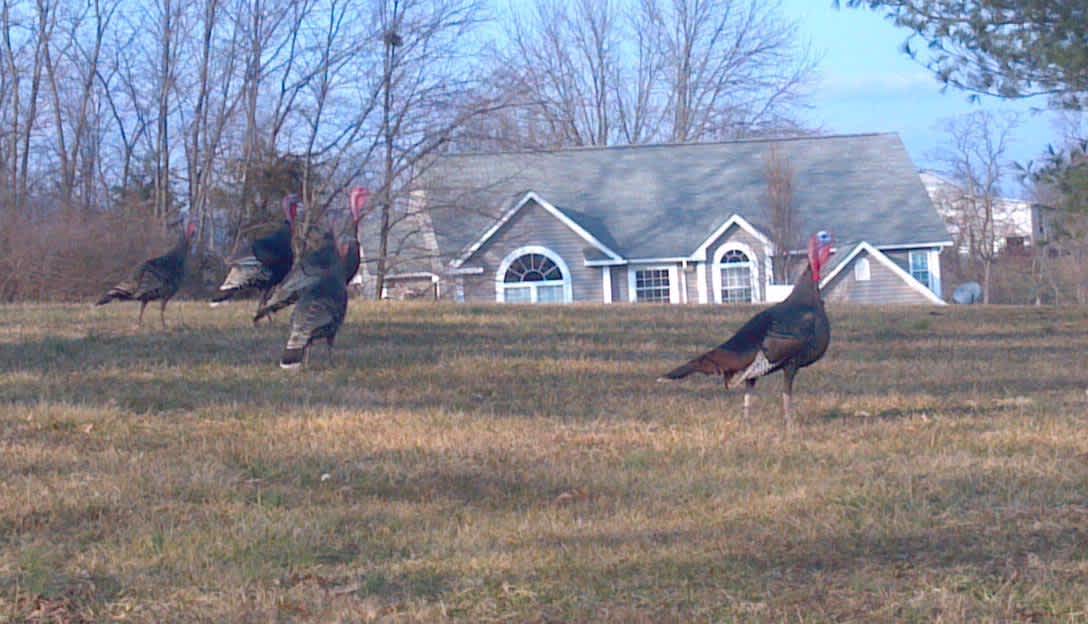Just a Few Turkey Facts
Real Outdoor World 02.27.12

Turkey season is fast approaching among us hunters and huntresses. I find it intriguing to know some facts about the wild turkey. I know some of us just go out and shoot a bird, but do you actually study them? I decided this year I would do some research on the wild turkey and share with you some important facts.
I think it’s amazing that Benjamin Franklin’s first choice for the United States’ National Bird was the wild turkey. The turkey was well liked by the Native Americans as well as the Europeans. It was the choice for Thanksgiving Dinner. It’s also the largest game bird in North America.
In the early 20th century wild turkeys were no longer roaming over the land. They had been killed off by hunters and many of their woodland habitats were destroyed. It’s thanks to the conservation programs we have now that wild turkeys are not extinct. We now have five different types of turkeys that are grouped in slams for turkey hunting.
These are five slams:
- Grand Slam: Eastern, Rio Grande, Merriam’s and Osceola (Florida Birds)
- Royal Slams: Eastern, Rio Grande, Merriam’s, Osceiola, and Gould’s
- World Slams: Eastern, Rio Grande, Merriam’s, Osceiola, Gould’s, and Ocellated
- Mexican Slams: Rio Grande, Oscellated, and Gould’s harvested only in Mexico
- Canadian Slams: Eastern and the Merriam’s are harvested in the Provinces- Ontario, Quebec, Alberta, Manotoba or British Columbia
The male turkey is also known as the gobbler or the tom. They usually have large red, featherless red- head, red throat, red wattles (warts or abnormal growths) on throat and neck. The long fleshy skin that lay over the beak is called a snood. When they get excited the blood rushes to the head and neck causing the snood to expand and may even conceal the eyes and the beak. When they’re ready to fight the head and neck turn blue. The Toms are known to have beards and the longest beard reported through the National Wild Turkey Federation is 18 inches long. They also have little reddish-yellow to grayish-green legs and a black body. The male is substantially larger than the female, and his feathers have areas of red, purple, green, copper, bronze, and gold iridescent shade. The primary wing feathers have a white bar through them. The bird can have up to 5000-6000 feathers on them. Their wings expand up to 47-59 inches. The adult males weigh 16-24 lbs. The record-sized adult male, according to the National Wild Turkey Federation, weighed 37 lbs.
The female turkeys are smaller in size weighing 8-12 lbs. Their color is dark dull gray and sometimes black. They camouflage the nest very well. The hens can lay 10-14 eggs and the incubation period is 28 days. Some beards are found on 10-20% on hens.
Turkeys are known to be omnivorous. They eat fruit such as juniper and bearberries in addition to seeds, insects, frogs, roots, acorn and nuts. They even eat small reptiles such as snakes, lizards, and frogs. They eat spiders and other insects that are found on the ground or in trees. They eat grain that is grown out in the field. They also eat tall variety wild grasses.
The sounds they make are yelps, gobbles, clucks, purrs, putts, whines, cackles, and kee-kees. Their gobbles can carry up to a mile. In the spring time they’re announcing their presence to the hen and other males. The males are polygamous and mate with as many hens as they can. They attract females by puffing out their chest, dragging their tails, and expanding their wings. This known behavior is called strutting. Their color also changes around their head and neck. The mating season is March and April. The female hens yelp to let the gobbler know their presence. The immature turkeys are called jakes and they often yelp.
The turkeys nest up in a tree along streams at night to protect themselves from other preying animals. They have very poor night time vision. Turkeys have very good eyesight and hearing at daytime. They’re also extremely fast runners.
Wild turkeys have a pecking order, it’s usually the oldest to the youngest.
I enjoyed learning about the wild turkey that I will be hunting this spring. Remember it’s not about the kill, but the fun of hunting and enjoying wildlife. Seeing all the wildlife up close and personal and studying them is exciting to me. You just need to sit back, be patient, and observe. You will be amazed at what you see.
If you’re looking at registering your Wild Turkey this year with the National Wildlife Turkey Federation please check out this link http://www.nwtf.org/all_about_turkeys/records_FAQ.html
Have fun and be safe on your wild turkey hunting excursion, and remember to always use common sense while you’re hunting. Practice your turkey calling off-season so you can be prepared doing the turkey season. To improve your hunting skills watch videos and turkey hunting shows to help you become a superior turkey caller.

